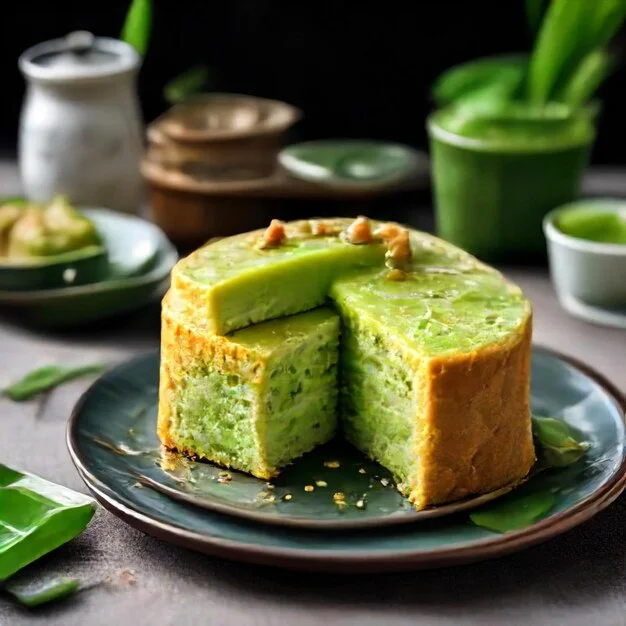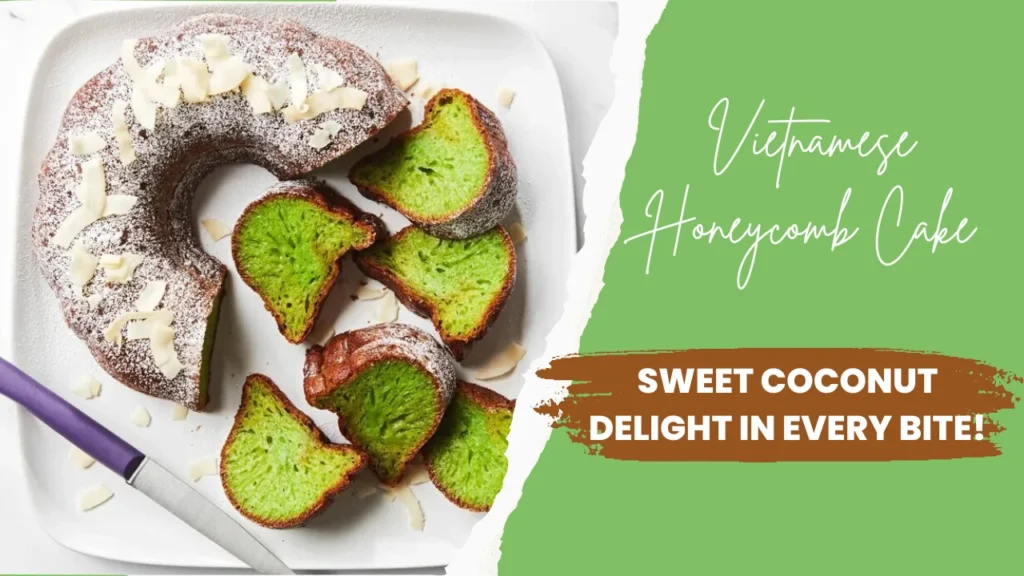Banh bo is also known as Vietnamese honeycomb cake or cow cake. It’s a delicious Vietnamese dessert packed with coconut flavor and pandan. The tapioca and eggs make it light, fluffy, and chewy. My mom taught me how to bake this treat, and I will now show you the best way to make it while avoiding common errors.
This recipe is not easy. Attention to detail is required for a perfect result. If you improvise or substitute ingredients, you may get unexpected results. Making banh bo (Vietnamese Honeycomb Cake) is fun and delicious, so let’s get baking!
What makes this Honeycomb Cake Delightful?
My mother has been baking and cooking for decades. I learned from her. She has spent the last year perfecting a banh-bo recipe with countless tests. She tried different baking powders and mixing methods. She also experimented with sugar ratios, types of sugar, baking temperatures, cake molds and baking temperatures.
She has finally found a recipe she enjoys after countless attempts to perfect it. This Vietnamese Honeycomb cake recipe reflects many of my preferences and requires specific ingredients and techniques. I’ll guide you!
What is Vietnamese Honeycomb Cake?
Bánh bò comes in two types: steamed and baked. In this recipe, we’re making bánh bò nướng, the baked version. This cake is soft and spongey with a slight chew, and it has the delightful flavors of coconut and pandan.
The baked bánh bò has a crispy, browned crust on all sides, unlike the steamed version, which doesn’t develop this crust. After baking, you cut the cake into slices like a pie, and it’s perfect to enjoy with coffee.
Different Names of This Honeycomb Cake

Thanks to Vietnamese-Americans and interest from non-Vietnamese people, this cake has many names:
- Bánh bò
- Honeycomb Cake
- Vietnamese Honeycomb cake
- Vietnamese cow cake
- Vietnamese baked/steamed rice cake
- Vietnamese green coconut cake
The original name, bánh bò, translates to “cow cake” in Vietnamese. The honeycomb-like appearance of the cake also leads to its other name, “honeycomb cake.”
The Ingredients
Here’s a simplified guide on how each key ingredient affects your cake, along with substitution tips:
- coconut milk
- defrosted pandan leaves
- large whole eggs
- vanilla powder
- granulated white sugar
- granulated salt
- tapioca starch
- rice flour
- single-acting Alsa baking powder
- coconut oil
- nonstick cooking spray
Granulated White Sugar: This is the standard sugar you likely have. You can use palm sugar instead, but you must melt and dissolve it with coconut milk before mixing it with the other ingredients.
Single-Acting Baking Powder: This recipe requires single-acting baking powder. If you use double-acting baking powder, it might change the texture of the cake.
Oil: While butter is often used, coconut oil is preferred for better flavor. If you use butter, melt it thoroughly before adding it to the batter to ensure it mixes well.
Coconut Milk / Coconut Cream: Both will work, but coconut cream will make the cake richer.
Powdered Vanilla: You can use liquid vanilla extract if you don’t have powdered vanilla. Vanilla helps mask the smell of eggs, but if you’re using fresh pandan, the egg smell won’t be as noticeable.
Steps To Make
To make the Vietnamese Honeycomb Cake, follow the steps.
- Preheat your oven to 350°F. Wash, defrost, and dry the pandan leaves thoroughly. Blend the pandan leaves with coconut milk in a high-speed blender, like a Vitamix, until the leaves are roughly the size of rice grains. Avoid blending too finely to prevent a bitter, grassy taste. Strain the mixture through a fine mesh strainer into a bowl, extracting as much coconut milk as possible and leaving behind the pandan pulp.
- Mix tapioca starch, rice flour, and baking powder in another bowl. Whisk and sift the mixture to remove any lumps.
- In a third bowl, beat eggs, sugar, vanilla powder, and salt with an electric hand mixer on LOW speed. Gradually add half of the flour mixture and mix for 30 seconds.
- Add all the coconut milk and mix for 30 seconds. Stir in the remaining half of the flour and mix for 40-50 seconds until well combined. Add cooking oil and mix. Pour the batter through a fine mesh strainer to remove lumps, then strain it again.
- Spray your cake mold with cooking spray. Pour the batter into the mold slowly and evenly, filling it between 1/2 and 2/3. Be careful not to overfill, or the batter might overflow as it rises.
Baking
- Bake the cake at 350 °F in a preheated oven for 45 minutes or until a cake tester comes out clean. If you’re using a smaller mold, reduce the cooking time slightly. If needed, broil for 1 minute to brown the top. After baking, leave the cake in the oven with the door slightly ajar for 10 minutes.
- Next, flip the cake mold onto a cooling rack set on cans or ramekins. Let the cake simmer down to ambient temprature. To speed up cooling, you can use a fan. Once cooled, run a knife around the edges to loosen the cake, then gently pry it away from the mold with your fingers to release it.
How To Store
Vietnamese Honeycomb Cake is best enjoyed fresh, right after baking and cooling. It doesn’t store well: you can keep it on the counter for a few days, but it can spoil quickly. If you put it in the fridge, it will become stale. To revive slices from the fridge, slightly microwave them before serving. For the best experience, share and enjoy bánh bò with friends and family as soon as possible.
Frequently Asked Questions (FAQs)
Why is it called banh bo?
In Vietnamese, “bánh” means “cake,” and “bò” can mean “cow” or “to crawl.” According to Paulus Huỳnh Tịnh Của’s 1895 dictionary, Đại Nam quấc âm tự vị, the dessert’s name refers to its shape, which looks like a cow’s udder. This suggests that “bánh bò” is a shortened form of “bánh vú bò.”
Why is honeycomb not vegan?
Bees build honeycombs from beeswax to store pollen, larvae, and honey. Since honey and honeycomb come from animals, they are not vegan.







